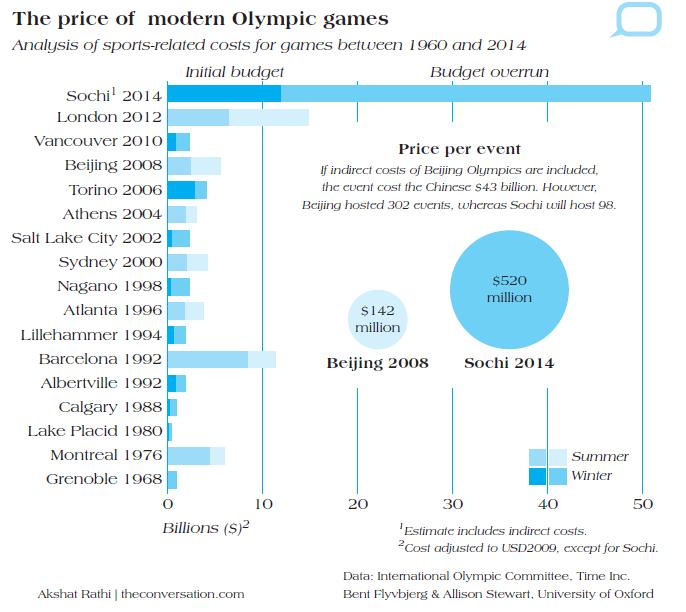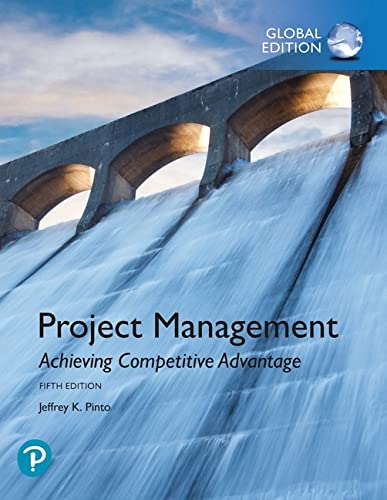The Olympics happen every two years and the focus is usually centered mostly on the athletes, but
Question:
The Olympics happen every two years and the focus is usually centered mostly on the athletes, but 2014 proved to be different. Instead, topics of overspending, terroris threats, graft and corruption in high places, and criminal activities took center stage during these winter games. With an initial budget of $12 billion, the final price tag on the Sochi Olympics is estimated to have surpassed $51 billion, leaving many people scratching their heads. How could the Winter Games become so expensive, and where did all the money go?
Previously, the most expensive games were the 2008 Beijing Summer Olympics. However, at an estimated price tag of $40 billion, that total was still far less than the Sochi Olympics. Summer Olympics are also generally more expensive than the Winter Games due to more events being conducted, the need for venue construction, and the higher housing costs for larger teams.
When it comes to hosting the Olympics, it seems that preliminary budgets are quickly abandoned, with higher and higher price tags accruing. Countries view hosting the Olympics as an opportunity to showcase their national achievements, so little effort is made to spare expenses. Even by these standards, the Sochi Olympics set a new standard for profligate spending.
Historically, the average budget overspending for Olympics between 1960 and 2012 is 179% in real terms and 324% in nominal terms. The final bill for the Sochi games is far worse than these historical averages.
In 2007 when Russia won the bid to host the Winter Olympics against fellow finalists from South Korea and Austria, it promised to spend $12 billion. Although this figure was reasonable (and perhaps even excessive)
at the time, it was quickly overtaken by events involved in developing the Sochi site. The key question is, how did the original budget of $12 billion become a final price tag of $51 billion? There are several reasons for the escalating cost of the Sochi Games, including:
1. Although host to the Winter Games, Sochi is a subtropical climate. Temperatures average 52 degrees in the winter and 75 degrees in the summer.
There are even palm trees in this location. So the majority of the skiing events had to be held in the mountains of Krasnaya Polyana, a distance of about 25 miles from Sochi. The cost of constructing the roadway and infrastructure used to transport athletes and spectators back and forth came to a mind-boggling $9.4 billion. At a price of $220 million per kilometer, the roadway was more expensive than the entire budget of the 2010 Vancouver Winter Olympics.
2. Vladimir Putin, President of Russia, had the goal of developing Sochi as a world-class ski resort to attract winter tourism to the country. Thus, he was a highly visible spectator throughout the project’s development, offering suggestions and criticisms of the work being done. Rework on several of the venues and facilities added to the final bill.
3. Fears of terrorism and other disruptions led to an unprecedented level of security around the Sochi site. For example, troops from Russia’s Interior Ministry cordoned off the Olympic area to a depth of nearly 20 kilometers to enforce a safezone around the Games. The costs of heightened security added significantly to Sochi’s costs.
4. Projects needed to be rebuilt several times due to difficulties with terrain or resource management.
For example, state planners did not account for streams that ran beneath the location of the venues.
This oversight caused an embankment near Olympic Park to collapse repeatedly due to constant flooding, each time having to be rebuilt.
Likewise, construction of the ski jump was budgeted for $40 million. However, because of the complex terrain, the placement had to be adjusted many times. It was also alleged that the necessary geological tests were not conducted before construction started. Trees were removed as needed, leaving several structures constructed on fragile soil that was prone to recurring landslides, which caused more rebuilding. In the end the ski jump was completed, but for $265 million, rather than the initial $40 million estimate.
5. Kickbacks and graft were rumored to be rampant during the years of development, with insiders getting “sweetheart” deals from the government and cronyism running rampant.
How bad was the corruption? As journalist Brett Forrest noted, “The Sochi Internal Affairs department has conducted numerous investigations into Olympstroy
[the Russian Olympic organizing commission] and filed criminal complaints, alleging that the Olympic agency and its contractors operated a kickback scheme related to the construction of the Olympic stadium, the main hockey rink, and various other properties. The total in stolen funds, per prosecutors, approaches $800 million.”
This may have been only the tip of the iceberg.
Besides the speculated kickbacks, a green light was given to all development schemes around Sochi. Contractors sought to have their projects labeled “Olympic,”
knowing that they would receive generous funding as
a result, including easements in zoning and building code regulations. There were also widespread allegations of cronyism, as friends and business associates of high-ranking Kremlin officials, including Vladimir Putin, received the choicest contracts. One opposition politician, Boris Nemtsov, criticized the substantial overspending, stating that the total amount embezzled or acquired by Putin’s friends was in the range of $25–
$30 billion, or more than half of the total budget for the Olympic Games. Construction companies that won contracts would have to inflate their projected costs to make the kickback payments to Russian State managers who had originally awarded the contracts. Per Nemtsov, it did not matter if the construction company had sufficient resources and skills for the project; what mattered was the company’s willingness to return a percentage to the corrupt officials.
Many issues contribute to the reasons why these Olympics became so expensive. Russia had a concept that was budgeted at $12 billion when it started its preparations. History shows that most nations exceed their budgets, though not to the excessive degree experienced by Russia in 2014. Ultimately, though, time is a relentless enemy of Olympic venue preparation; there is no possibility of extensions to the schedule. Thus, with the time moving closer to the opening of the Games, no expense could be spared in getting Sochi ready. Without question, enormous (and probably unknowable) sums disappeared due to corruption and mismanagement.
Nevertheless, the Sochi Games came on time and delivered a smoothly running experience to all who participated or came to watch. And yet, at a final price tag of $51 billion, one can still wonder about the costs of maintaining and enhancing national prestige.
Questions
1. Consider the following statement: “Government funded projects intended to serve as ‘prestige projects,’ such as the Sochi Olympics, should not be judged on the basis of cost.” Do you agree or disagree with this statement? Why?
2. Project success is defined as adherence to budget, schedule, functionality (performance), and client satisfaction. Under these criteria, cite evidence that suggests the Sochi Olympics project was a success and/or failure.
Step by Step Answer:

Project Management Achieving Competitive Advantage
ISBN: 9781292269146
5th Global Edition
Authors: Jeffrey K.Pinto





